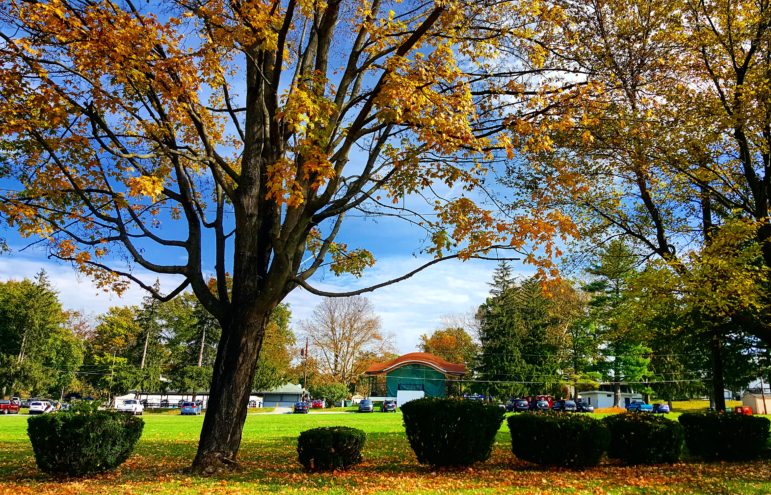
Yellow leaves in Dimmick Park, Hellertown
The spectacular seasonal color display staged by deciduous trees as they prepare for winter has long been regarded by many as the peak period of beauty. Resort areas in locations where leaves are especially brilliant do a brisk business in September and October, and homeowners and professional landscapers frequently select and plant trees on the basis of their fall display alone.
Several chemical processes are at work determining leaf color and intensity. Photosynthesis, the food-making process of the leaf, utilizes sunlight and the green pigment, chlorophyll, to manufacture sugars. Chlorophyll is unstable and is constantly being synthesized and broken down. Green is not the only pigment found in the leaves. In fact, there are three color pigments in a tree: green, yellow and red. All are created by the plant at different times throughout the year and are found in various concentrations within the leaf. Green chlorophyll is present throughout the growing season and is so plentiful that it masks the presence of the other pigments. Unlike chlorophyll, these other pigments are chemically stable and remain in the leaf throughout the season. The red pigments in a leaf are not synthesized until late in the growing season and their creation is dependent upon high sugar and tannin concentrations in the leaf combined with bright sunny days followed by cool nights.
Contrary to the widely held belief that leaf color change is produced by early fall frosts, a combination of bright days and cool nights sets the chain of events in motion that results in the brilliant shades of autumn. By fall there are approximately three hours less of sunlight than during the height of summer, and light rays tend to be reflected rather than absorbed. These changes result in a reduction in photosynthesis that results in a reduction in chlorophyll production. Within a short time, this unstable green pigment (chlorophyll) already present in the leaf breaks down, and the underlying yellow pigments are revealed.
At the same time, the combination of shorter days and cooler temperatures trigger the formation of a thin wall of cells where the leaf is attached to the twig, effectively shutting off the flow of water and bringing to a halt further sugar and chlorophyll production. Unless red pigments are present, the leaf will appear yellow. Brilliant shades of red will predominate in some species, however, if the days have been sufficiently bright to produce large quantities of sugar and the nights sufficiently cool to trap it within the leaf. Intermediate hues between yellow and red represent a blending of pigments.
Many people ask why the same tree may have different intensities of color from year to year. This is because the red pigment content is highly dependent upon weather conditions and can vary greatly from year to year. Furthermore, these red pigments are water-soluble and are primarily located in the upper portion of the leaf, thus obscuring the yellows either partially or totally.
Other factors that play a role in the development and intensity of fall coloration are the tree’s exposure and elevation, genetic makeup and the prevailing soil conditions. More intense color can usually be found on plants growing in full sun, and often the western side exposed to later afternoon rays will be more brilliant. Trees growing in low-lying areas where cooler night air settles will be the first to show color. Soil conditions such as pH determine color to some degree, as nutrients taken up by a tree are utilized in the synthesis of the leaf pigments and sugars.
We are fortunate to live in the Northeast where this seasonal display happens each year. Make some time this fall to go out and enjoy this biochemistry in action!
Robert Andreucci is a local science teacher and arborist. Follow him on Twitter: @ScienceMrA.







